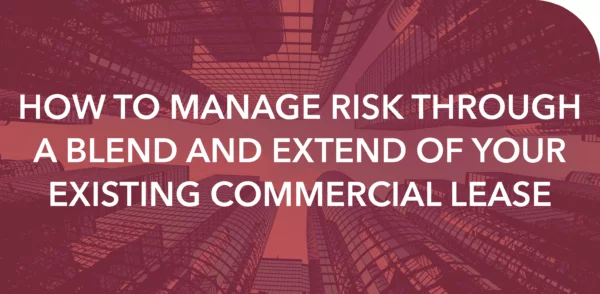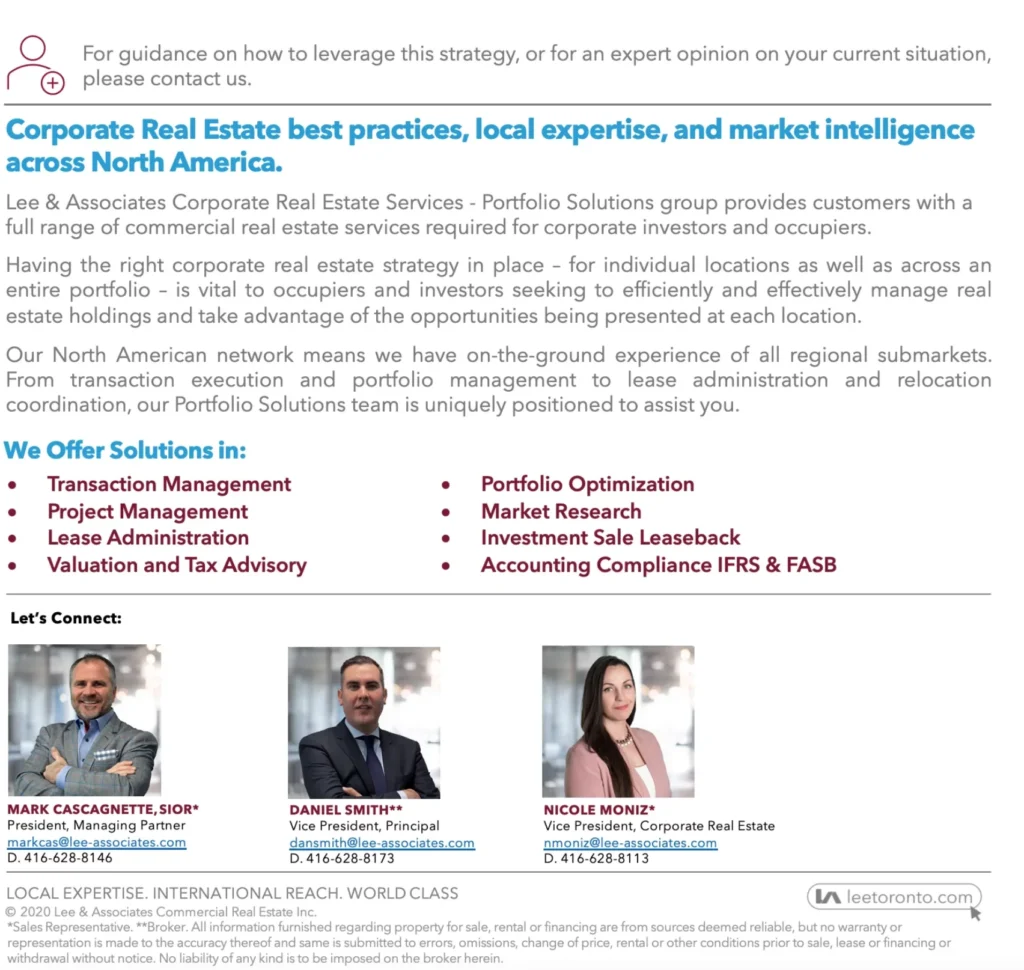HOW TO MANAGE RISK THROUGH A BLEND AND EXTEND OF YOUR EXISTING COMMERCIAL LEASE
November 5, 2020

MANAGE RISK | INTELLIGENCE BRIEF
As businesses around the globe look to navigate through uncertain times, the focus for most corporations has been centered around two areas. On the talent side, considerable resources have been dedicated to improving productivity and ensuring the labour force can continue to work safely in remote settings. Secondly, management teams have tried to develop strategies to reduce risks and costs associated with the business. Whether to decrease their burn rate of cash or to react to the changing landscape, firms are looking through their books and consistently seeing one particular line item jump out at them: REAL ESTATE.
Ultimately, corporations will begin to shed unused space and find ways to consolidate. Depending on the type of business and the mix of space in your portfolio, this percentage may vary greatly. That being said, no matter if you find yourself in an advantageous or disadvantageous situation, there do exist strategies with which to lock in rates and add some predictability and forecasting-ability to your financial models.
What is a Blend and Extend?
A ‘blend and extend’ is a strategy used by Tenants of commercial space to help manage and forecast their real estate costs, as well as to ensure the continuation of their tenancy. This is done by conducting a lease renewal prior to the term expiry, adding an additional term to the length of the lease in exchange for more favourable rates and/or concessions.
Alternatively, a ‘reverse blend and extend’ may be leveraged by a Landlord to soften the blow from sharply decreasing market rental rates upon renewal, and may offer the Tenant an immediate reduction in real estate costs for assurances that they will not relocate upon expiry.
The new rate is typically calculated using the existing rental rate, the existing market rate for similar properties, as well as the projected growth in market rental rates.
This strategy may be employed on single space leases, or across a portfolio, depending on the Tenant and/or Landlord, as well as their preferences and situations. Finally, these types of lease renewals are often done well in advance of expiry; anywhere from 12 months to several years, depending on the circumstances at hand.
Why Use a Blend and Extend?
Using a ‘blend and extend’ is all about COST and RISK MANAGEMENT.
Impact on a Tenant:
In a scenario where the existing rental rate is far below the market rate, this would mean a Tenant is likely to see a drastic increase in their rents upon renewal. While they may be able to relocate or renegotiate in a timely fashion, some markets have chronically low availabilities, making this a difficult task for the broker and Tenant. In order to ensure both the continuation of operations and a reasonable rental rate for the Landlord, a Tenant can ‘lock in’ early and, in doing so, receive more favourable terms. This is often welcomed by Landlords who are looking to avoid vacancies in their portfolios, Tenant Improvement Costs associated with leasing to a different Tenant, as well as other related risks or transaction costs.
Impact on a Landlord:
In a scenario where the existing rental rate is far above the going market rate, such as what may be prevalent in certain office and retail markets in 2020… a Landlord may wish to proactively engage and deal with their Tenants to maximize long-term cash flows while potentially giving an immediate reduction in rents and/or offering concessions to incentivize occupancy.
Example of a Blend and Extend
Tenant Market:
Example: An office tenant has 2 remaining years on their lease. They are currently paying $50/sf on 5,000 sf (or $250,000/year). However, due to increased vacancies in the area, average office rents have declined to $40/sf. The Tenant has an option to extend their Lease at a rate no less than what they are currently paying and is not planning on exercising this right. They approach the Landlord early and they agree to “blend and extend” the Lease, allowing them to pay a blended rate of $45/psf for the remaining 2 years of the current lease, and current market rate of $40/psf for the next 5 years of the lease.
In this scenario, the tenant would save $25,000/year over the two remaining years of their lease (a total of $50,000), while locking another 5 years at the present market rate, mitigating any risk of further increases and avoiding relocation costs. Generally, a landlord will not offer this unless they believe that rents are going to stay the same or fall over the remainder of the extended leasing period. Although the Landlord is agreeing to a reduced rent, they are able to stabilize their income for the foreseeable future and avoid a vacancy.
Below is a scenario more favourable to Landlords, reflective of the current industrial market (as of late 2020):
Landlord Market:
Example: A warehouse tenant has a year and a half remaining on their lease. They are currently paying $8.00/sf on 50,000 sf (or $400,000/year). However, due to high demand in the area, average industrial rents have increased to $12.00/sf. The Landlord is looking to boost their short term cashflow and approaches the Tenant to renew early. They agree to “blend and extend” the Lease, allowing them to pay a blended rate of $10/psf for the remaining year and a half on their lease, and current market rate of $12/psf for the next 5 years of the lease.
In this scenario, the landlord received a $150,000 boost in cashflow over the next year and a half, while securing their tenant for an additional 5 years. Although the Tenant is agreeing to increase their rate early (when they could have chosen not to), they are locking in at the current market rate that could arguably be even higher if they were to wait and negotiate in another year, therefore mitigating any further increases. This provides predictability for the Tenant and stability for the Landlord.
The Pros and Cons Associated with a Blend and Extend
Summary
Overall, Tenants and Landlords of commercial space are constantly looking for opportunities to minimize costs and risks associated with their real estate footprints and portfolios.
A ‘blend and extend’ is a tool that may provide immediate rent relief or longer-term assurances in costs that enable more accurate forecasting. Given the uncertainty in the world at-large, it may be prudent to explore all pertinent options available in order to make the best decision possible.

